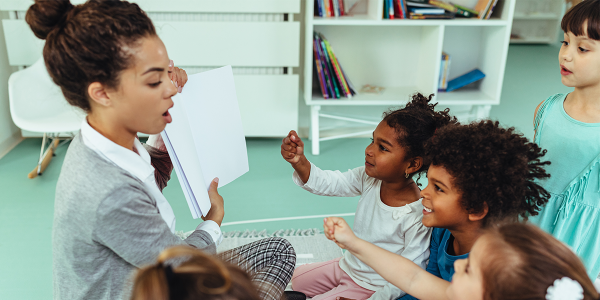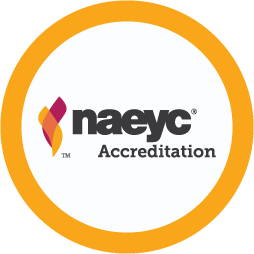Leveraging the Environment to Ignite Children’s Literacy Learning

You are here
Four-year-old Camila opens a class recipe book in the home environment center that includes photos and recipes from children’s families. She turns to her family’s recipe for corn tortillas. Pointing to the text, she says, “First, I have to put in la masa.” She dips a measuring cup into a canister with a picture and the words corn flour and masa on the outside, then dumps two imaginary scoops into a bowl. She returns to the book and says, “Then I have to put in the water.” Camila reaches for an empty pitcher and pretends to pour in water. She puts scraps of paper on a plate to represent a pile of tortillas then calls, “Tortillas for sale! Come have a hot, fresh tortilla!”
Tariq sits down. “I want a tortilla,” he says.
Teacher Olivia, who is documenting Camila’s play, joins the scene and prompts, “Oh, I think your customer might need a menu to help him decide what else he wants with his tortilla.” Camila picks up a clipboard and marker and begins to write strings of letter-like symbols. When she’s done, she hands the clipboard to Tariq and says, “We have cheese and chicken. What would you like?”
Opportunities to promote young children’s language and literacy development abound in early learning settings. Early childhood educators can facilitate these experiences by offering materials, routines, and interactions that set the stage for rich language and literacy activities and exchanges, as Olivia did in the vignette above. Among other literacy skills, the class recipe book allowed Camila to demonstrate her understanding of print concepts (such as holding the text correctly, flipping the pages, pointing to the words), to strengthen her oral language by integrating both of her languages, and to use her emerging writing skills through the use of strategically placed materials.
As teacher educators, we (the authors) work in racially, economically, and geographically diverse higher education contexts. Situated across two- and four-year institutions, we work with early childhood educators to develop their learning environments for children and families in rural and urban communities. Focusing on the ecology of the classroom allows educators to intentionally create opportunities throughout the learning day to foster children’s early literacy and language skills. In this article, we share ways to shape the classroom environment to immerse young learners in authentic literacy explorations.
Using Materials to Enrich Early Literacy Environments
The learning environment is a crucial part of early childhood education. Teachers are called to design and implement settings that help every child achieve their full potential across developmental domains and content areas. This includes opportunities to embed rich literacy experiences, such as the reading and writing tools Olivia included in the home environment center.
Teachers can use a variety of materials to promote children’s literacy. These include
- integrating books, interactive print materials, and other literacy props. Turning the dramatic play center into an animal shelter invites children to use animal name cards, adoption certificates, and veterinarian health charts. In the science discovery area, STEM-focused writing tools and print materials could include scientific illustrations, graph paper, markers, science logs, rulers, and lab books.
- emphasizing print by labeling classroom spaces. Working with children to label supplies (art supplies, musical instruments, blocks) and learning areas (storage areas, cubbies) with pictures, symbols, and/or words increases ownership and agency in these spaces and promotes literacy skills.
- honoring children’s diverse social identities. Knowing about and valuing children’s unique social and cultural experiences help teachers to include children’s home literacy assets and practices. Emphasizing literacy traditions found in oral storytelling, poetry, music, and the spoken word honors diverse literacy and language expressions. Providing props like finger puppets, felt boards, and costume accents for storytelling supports children’s narrative storytelling and reenactments.
Besides giving children daily access to literacy tools, these robust, intentional literacy environments also set the stage for teachers to facilitate children’s literacy engagement during everyday routines and interactions.
Using Routines to Spark Literacy Expressions
Both formal and informal routines occur across the learning day. Routines support children through transitions, mealtimes, and center time explorations. They also inform read-aloud activities, morning meeting discussions, and even outside play.
Teachers can integrate language and literacy opportunities into children’s routines by
- creating literacy activities that are personally relevant to children. Morning sign-in routines can start with pictures of children. Adding their names to these pictures draws children’s attention to the new text element and encourages conversations about the role of print. As children gain confidence in recognizing their names, teachers can remove the pictures, shifting the literacy environment again. Over time, children can progress to writing their own names to sign in.
- watching for opportunities to establish new child-initiated literacy routines and activities. When children notice ants on the playground, the teacher can prompt them to wonder how they can learn more about the insects. Following the children’s lead, the class could decide to create a “wonder investigation basket” with notebooks, informational texts about insects, writing tools, and magnifying glasses that can accompany outside play.
- enriching vocabulary through playful engagement with new words and concepts. Celebrating children’s literacy moments is an engaging and playful way to expand children’s word knowledge and their world (or background) knowledge. The “Recipe Chant” (see below) is one way Olivia, from the opening vignette, could reinforce the recipe book experience.
Recipe Chant
In this call-and-response chant, there is a bit of rhyming wordplay, recognition for individual children, and explicit use of key vocabulary (cookbook, recipe, tortillas) used in Olivia’s classroom.
Hey Hey (students echo Hey Hey)
We have a new recipe (A new recipe)
Camila’s tortillas (Camila’s tortillas)
It’s in our cookbook (It’s in our cookbook)
Be sure to take a look (Be sure to take a look)
Using Interactions to Support Children’s Literacy Engagement
Meaningful interactions occur in the context of relationships. A rich literacy environment offers children tools to develop reading, writing, listening, and speaking skills. However, the availability of materials and other literacy supports doesn’t guarantee that children will use them. Teacher-child interactions—such as conversations, modeling, scaffolding, and feedback—are critical.
Educators can expand children’s interactions and support their literacy experiences by
- responding with enthusiasm and encouraging conversational exchanges. Teachers can welcome children at arrival and engage them in conversation as they transition from unpacking to table activities. Supporting children in turn taking during conversation and extending their responses to include more vocabulary and longer sentences build important literacy skills.
- scaffolding children’s literacy and language use organically. Observing how children engage in the environment reveals opportunities for extending literacy. Olivia, for example, supported Camila and Tariq’s literacy play in the tortilla restaurant by suggesting the use of a menu.
- integrating, modeling, and using technology to support children’s literacy expressions. Educators can use technology and media to support meaningful interactions among children in the classroom and to connect families to the learning setting. (See “Using Technology to Foster Interactions” below for an example.)
Using Technology to Foster Interactions
Applications and programs like Book Creator and Flip allow children to use technology tools as creators rather than passive consumers. With the class recipe book, for example, Olivia could create a digital file and share the link with families, who could access it at home. Children could use an iPad or other device to access the file in the classroom. In this way, literacy learning is experienced across home and early learning settings.
Conclusion
Educators expand children’s literacy learning when they intentionally use their settings’ materials, routines, and interactions to center children’s interests and engagement in productive literacy tasks. To ensure your environment is promoting these essential early skills, we suggest asking:
- What space in your classroom could be enhanced with additional literacy materials?
- Where could you include a new routine or revise an old routine to promote literacy learning?
- How can you intentionally leverage your interactions with children to support literacy development?
Photograph: © Getty Images
Copyright © 2024 by the National Association for the Education of Young Children. See permissions and reprints online at NAEYC.org/resources/permissions.

 This article supports the following NAEYC Early Learning Programs standards and topics
This article supports the following NAEYC Early Learning Programs standards and topics
Standard 2: Curriculum
2D: Language Development
2E: Early Literacy
Leslie La Croix, PhD, is an assistant professor in the College of Education and Human Development at George Mason University in Fairfax, Virginia. Dr. La Croix facilitates early literacy and social studies professional development experiences and methods courses for early childhood educators. [email protected]
Kimberly Sanders Austin is professor of early childhood education at Southwest Virginia Community College in Richlands, Virginia.
Christine Pegorraro Schull is a professor of early childhood development at Northern Virginia Community College in Alexandria, Virginia.
Sara E. Miller, EdD, is a professor of education at Longwood University in Farmville, Virginia.
Julie K. Kidd is a professor emeritus at George Mason University in Fairfax, Virginia.